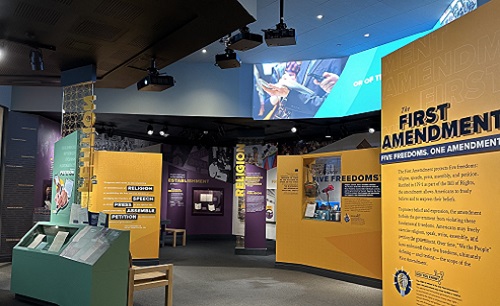
Constitution 101 Course
Start your constitutional learning journey


The 14th Amendment wrote the Declaration of Independence's promise of freedom and equality into the Constitution. Ratified after the Civil War, this amendment transformed the Constitution forever and is at the core of a period that many scholars refer to as our nation’s “Second Founding.” Even so, the 14th Amendment remains the focus of many of today’s most important constitutional debates (and Supreme Court cases). In many ways, the history of the modern Supreme Court is largely a history of modern-day battles over the 14th Amendment's meaning. So many of the constitutional cases that Americans care about today turn on the 14th Amendment.
Purpose
Ratified after the Civil War, the 14th Amendment wrote the Declaration of Independence’s promise of freedom and equality into the Constitution. It transformed the Constitution forever. And it’s at the heart of what many scholars refer to as America’s “Second Founding.” In this activity, you will examine why the 14th Amendment was needed in its own time.
Process
In this clip from FOURTEEN: A Theatrical Performance—an original play written and produced by the National Constitution Center—performers read sections of the Black Codes. White Southerners passed these laws after the Civil War, seeking to impose second-class citizenship on African Americans and reduce many formerly enslaved people to conditions that resembled slavery. However, African Americans fought back against these laws, often using petitions like the one in the clip from the South Carolina Colored Convention to advance their own vision of post-Civil War America.
Begin by reading the text of the Black Codes from South Carolina and Mississippi and the related background summaries from the Founders’ Library.
Then watch the video clip from FOURTEEN: The Black Codes.
In small groups, discuss the following questions and record your group’s answers:
As a class, share your group’s responses to the discussion questions.
Launch
Have the students read the text of the Black Codes from South Carolina and Mississippi and the related background summaries from the Founders’ Library. Then give students time to watch the video clip from FOURTEEN: The Black Codes and discuss the big ideas it presents.
Activity Synthesis
Have students share one takeaway from 14th Amendment: The Black Codes video that they did not know before watching the clip.
As a class, have students share their group’s responses to the discussion questions.
Use those responses to discuss the effects of Black Codes on African Americans in the South and to explore the role of state Colored Conventions in fighting for a different vision of post-Civil War America.
Activity Extension (optional)
Have students explore the Colored Conventions Project page and write a short essay on a new source.
Purpose
The 14th Amendment’s powerful language transformed the Constitution forever. In this activity, you will analyze the text of the 14th Amendment, break down its key parts, and explore the big ideas enshrined in its text.
Process
Watch the video of Reconstruction historian Eric Foner discussing the origins and meaning of the 14thAmendment. Video: Eric Foner on the Origins and Meaning of the 14th Amendment.
Next, complete the Activity Guide: Introduction to the 14th Amendment worksheet. Split up into groups, review your assigned a key clause of the 14th Amendment, and share with the larger group.
As background support, review the Info Brief: Reconstruction and America’s “Second Founding.”
Finally, present your group’s assigned clause to the class. If this is not your section, take notes and complete your worksheet. Your class will then discuss the big ideas contained in the 14th Amendment and how the amendment remains relevant today. Explore the following key questions:
At the end of this module, you will build your own virtual exhibit, so begin to take notes on the stories, images, primary sources, and Supreme Court cases that you may want to include in your exhibit. Think about what stories you will tell.
Launch
Review the big ideas of the 14th Amendment. There are multiple parts to the 14th Amendment. Focus on Sections 1 and 5.
As background, watch Eric Foner on the Origins and Meaning of the 14th Amendment and review Activity Guide: Introduction to the 14th Amendment.
Read the Amendment over as a class and then have students complete the worksheet in groups. Assign each group a key clause of the 14th Amendment. Have them read the Common Interpretation essay in the Interactive Constitution, use the Drafting Table tool to explore the debates over their clause and its framing history, and complete a chart on their assigned clause.
Activity Synthesis
Have students present their assigned clause to the class. Groups should address the following key questions:
Then as a class, have students summarize the significance of the 14th Amendment as a whole and its big ideas. What did it add to the Constitution?
Purpose
In this activity, you will explore how the 14th Amendment was created, what it says, and debates over how to interpret it.
Process
Watch the following video about the 14th Amendment.
Then, complete the Video Reflection: The 14th Amendment worksheet.
Identify any areas that are unclear to you or where you would like further explanation. Be prepared to discuss your answers in a group and to ask your teacher any remaining questions.
Launch
Give students time to watch the video and answer the questions.
Activity Synthesis
Have students share their responses in small groups and then discuss as a class.
Purpose
The 14th Amendment is the focus of many of the most important constitutional debates (and Supreme Court cases) today. In many ways, the history of the modern Supreme Court is really a history of modern-day battles over the 14th Amendment’s meaning. So many of the constitutional cases that you care about today turn on the text of the amendment. In this activity, you will connect cases to the clauses and big ideas in the 14th Amendment, and then summarize the cases for your assigned theme.
Process
Complete the Case Brief: Tests of the 14th Amendment worksheet to review key cases based on the 14th Amendment’s big ideas.
Each group completes a short presentation of the case for the class that includes visuals.
Launch
Briefly review the cases that students will research and assign small groups to each case.
Activity Synthesis
Have students share their assigned Case Brief: Tests of the 14th Amendment with a short presentation of the case for the class that includes visuals and quotes.
Activity Extension (Optional)
Have students analyze cases that limit the 14th Amendment: The Slaughter-House Cases, the Civil Rights Cases, and Plessy v. Ferguson. Read the excerpts in the Founders' Library and develop a case brief for the class.
Purpose
The 14th Amendment’s powerful language transformed the Constitution forever. In this activity, you will design your own museum exhibit to teach about the history and significance of the 14th Amendment.
Process
Complete the Activity Guide: Showcasing the 14th Amendment worksheet and then create your own interactive museum exhibit that showcases the 14th amendment using the Activity Tool: Create Your Own Museum.
Launch
Discuss with students the role of museums as keepers of history. Share with them this quote. “Museums are storytellers. They exist because once upon a time some person or group believed there was a story worth telling, over and over, for generations to come.” - Leslie Bedford
Activity Synthesis
Students are tasked with building their own online exhibit. Prior to launching into activity, discuss with them the goal of a museum, the role of storytelling but also the burden of choosing who’s story to tell and from what perspective.
Key questions to place on board for their work:
Encourage students to add images, video, text, and audio to make their exhibit multimodal and engaging.
Purpose
Congratulations for completing the activities in this module! Now it’s time to apply what you have learned about the basic ideas and concepts covered.
Process
Complete the questions in the following quiz to test your knowledge.
Launch
This activity will help students determine their overall understanding of module concepts. It is recommended that questions are completed electronically so immediate feedback is provided, but a downloadable copy of the questions (with answer key) is also available.
With the Constitution, the Founding generation created the greatest charter of freedom in the history of the world. However, the Founding generation did not believe that it had a monopoly on constitutional wisdom. Therefore, the founders set out a formal amendment process that allowed later generations to revise our nation’s charter and “form a more perfect Union.” They wrote this process into Article V of the Constitution. Over time, the American people have used this amendment process to transform the Constitution by adding a Bill of Rights, abolishing slave...


Explore our new 15-unit core curriculum with educational videos, primary texts, and more.

Search and browse videos, podcasts, and blog posts on constitutional topics.

Discover primary texts and historical documents that span American history and have shaped the American constitutional tradition.